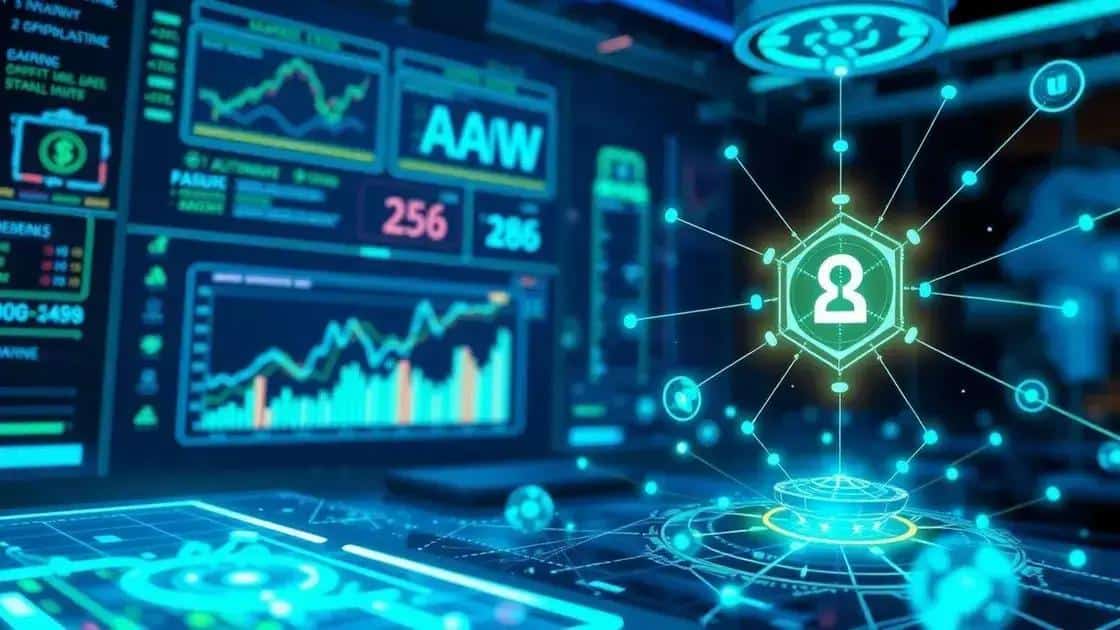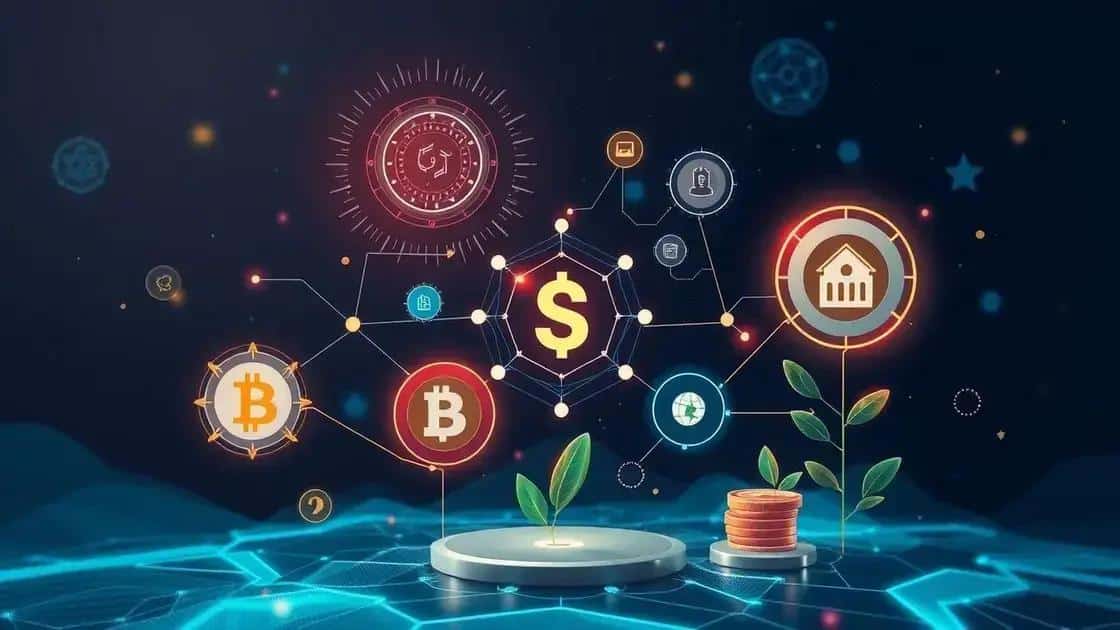What’s new in defi loan platforms: exploring innovations

What’s new in DeFi loan platforms includes enhanced accessibility, lower fees, AI integration for personalized lending, and a focus on sustainability, continuously shaping how users interact with financial services.
If you’ve been following the crypto space, you might be curious about what’s new in defi loan platforms. These platforms are rapidly evolving, creating exciting opportunities and challenges in the financial world. Let’s dive into the latest developments.
Understanding DeFi loan platforms
Understanding DeFi loan platforms can seem complex, but breaking it down helps clarify their function. DeFi, or decentralized finance, has transformed traditional lending by removing intermediaries. This new system relies on smart contracts, which automatically execute agreements once conditions are met.
By leveraging blockchain technology, DeFi loan platforms ensure transparency and security. Anyone can borrow or lend without the need for banks, making finance accessible to all.
How DeFi Loan Platforms Work
DeFi platforms utilize various mechanisms to function effectively. A few important elements include:
- Smart contracts: These are self-executing contracts with terms directly written into code.
- Collateral: Borrowers typically need to provide collateral to secure a loan.
- Interest rates: Rates are often determined by supply and demand on the platform.
- Liquidity pools: Users can deposit funds into these pools, providing capital for loans.
Borrowers and lenders interact directly, enabling flexible terms and conditions. This peer-to-peer approach not only enhances accessibility but also fosters competitive rates. It’s important to note that risks remain, including smart contract vulnerabilities and market fluctuations.
Advantages of Using DeFi Loans
DeFi loans come with several benefits that make them appealing:
- Accessibility: Anyone can access funds without traditional credit checks.
- Lower fees: Transactions are often cheaper due to reduced overhead costs.
- Control: Users have full control over their assets.
As more individuals and businesses turn to decentralized platforms, the landscape of borrowing and lending continues to evolve. Understanding DeFi loan platforms is crucial for anyone looking to engage in this transformative financial sector.
Key innovations changing the landscape

Key innovations changing the landscape of DeFi loan platforms are reshaping how we think about borrowing and lending. These advancements not only enhance user experience but also increase security and accessibility in the financial industry.
One major innovation is the introduction of flash loans. Unlike traditional loans, flash loans allow users to borrow funds without collateral, provided they repay the loan within the same transaction. This feature opens doors for arbitrage opportunities and quick capital movement.
Automated Market Makers (AMMs)
Another significant change is the rise of Automated Market Makers. AMMs utilize algorithms to set prices and help facilitate trades, providing liquidity without the need for traditional market makers. This shifts the balance of lending and borrowing, making transactions more efficient.
- Instantaneous transactions: AMMs can execute trades quickly, reducing wait times.
- Lower fees: Because they operate without middlemen, transaction costs are often lower.
- 24/7 availability: Users can trade anytime, unlike traditional banks.
Additionally, advancements in layer 2 solutions are enhancing scalability. These solutions help reduce congestion on the primary blockchain, resulting in faster and cheaper transactions. Users benefit as they can carry out operations without worrying about network fees during peak times.
Reputation-based lending
Another exciting innovation is reputation-based lending, where users can borrow based on their creditworthiness in the DeFi ecosystem. This system encourages responsible borrowing as it rewards users for good behavior. As transparency improves, the community can assess risk much better, leading to more informed decisions.
Implementing insurance protocols is also gaining popularity. These protocols help protect users from potential losses due to smart contract failures or hacks. The more confident users feel, the more likely they are to engage with DeFi platforms.
As these innovations unfold, we see a dynamic shift in the DeFi lending landscape, making it more user-friendly and secure. Staying informed about these changes is essential for anyone looking to dive into the DeFi space.
Benefits of using DeFi loans
There are significant benefits of using DeFi loans that distinguish them from traditional lending methods. These advantages have garnered much attention from users seeking flexibility and accessibility in financial services.
One of the primary benefits is higher accessibility. Anyone can access DeFi loans without needing a traditional bank account or credit history. This opens up borrowing options for individuals who may have been excluded from conventional financing.
Lower Fees and Costs
DeFi loans typically involve lower fees than traditional loans due to the absence of intermediaries. Users can save money on transaction costs, making borrowing more affordable. Many platforms also have lower interest rates since they operate on competitive decentralized networks.
- Transparent pricing: With no hidden fees, users can easily see the costs associated with their loans.
- No minimum balances: Unlike banks, DeFi platforms often do not require minimum loan amounts.
- Flexible terms: Borrowers can negotiate loan conditions that fit their needs.
Another important aspect is the speed of transactions. DeFi loans can be processed almost instantly due to reliance on blockchain technology. Users can receive funds rapidly without lengthy approval times typical in banks.
Security and Control
DeFi platforms also offer enhanced security through the use of smart contracts. These digital contracts execute automatically based on predefined conditions, minimizing the risk of default. Users retain control over their assets, allowing them to manage and monitor their finances directly.
The integration of blockchain technology means that all transactions are recorded on a decentralized ledger, ensuring transparency. This can build trust among users, as they can verify transactions at any time.
As the DeFi landscape continues to evolve, these benefits are likely to attract more users, making decentralized lending an essential part of the financial ecosystem. The combination of accessibility, lower costs, speed, and greater control are reshaping the way people approach borrowing.
Future trends in DeFi lending

As we look ahead, future trends in DeFi lending promise to redefine how users interact with financial services. Several emerging patterns indicate a shift towards more advanced and user-centric models, enhancing the functionality of decentralized platforms.
One significant trend is the integration of artificial intelligence (AI) into DeFi lending platforms. AI can improve credit scoring by analyzing an individual’s transaction history and behavior in real-time. This advancement will lead to more personalized loan options for users, making the borrowing process more accessible.
Enhanced Interoperability
Another trend is the push for interoperability between different DeFi platforms. As various ecosystems evolve, allowing seamless interaction among them will become vital. Users will benefit from being able to move assets effortlessly across platforms, reducing friction in the lending process.
- Cross-chain functionality: This enables users to access services from multiple blockchains, enhancing flexibility.
- Unified wallets: Users can manage assets from different platforms in one wallet.
- Improved liquidity: Cross-chain lending will bolster liquidity by tapping into multiple markets.
Additionally, governance models in DeFi are likely to evolve, empowering users with more control over platform rules. Many projects are exploring ways to decentralize decision-making further, allowing community members to influence the direction of their lending ecosystems.
Focus on Sustainability
Another future trend is a growing emphasis on sustainability within DeFi lending. Projects that prioritize environmental concerns and energy-efficient practices will gain traction. The industry is recognizing the need to reduce its ecological footprint and create lending solutions that align with global sustainability goals.
Innovations such as green bonds and eco-friendly investment options may emerge, encouraging users to support projects that positively impact the environment while earning returns.
As these trends develop, it’s crucial for users and investors to stay informed and adapt their strategies accordingly. The DeFi landscape is continuously changing, setting the stage for exciting new possibilities in lending.
As DeFi lending continues to grow, it brings exciting opportunities for users and investors alike. The key benefits, such as accessibility and lower fees, make decentralized loans attractive. Emerging trends, including the use of AI, enhanced interoperability, and a focus on sustainability, are shaping the future of this space. By understanding these concepts, individuals can make informed decisions and take advantage of what DeFi has to offer. As always, staying updated with the latest developments is essential for success in this rapidly changing landscape.
FAQ – Frequently Asked Questions about DeFi Lending
What are the main benefits of using DeFi loans?
DeFi loans offer accessibility without credit checks, lower fees due to no intermediaries, and rapid processing times.
How does AI improve DeFi lending?
AI enhances credit scoring by analyzing user behavior, leading to more personalized loan options.
What is interoperability in DeFi?
Interoperability allows different DeFi platforms to communicate, enabling users to move assets seamlessly and access diverse services.
Why is sustainability important in DeFi?
Sustainability in DeFi helps reduce the ecological footprint of financial transactions and promotes environmentally-friendly practices.





